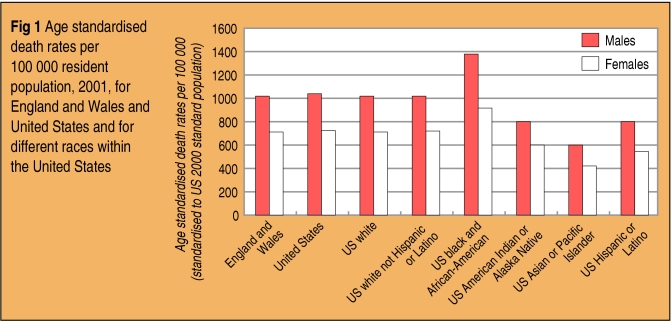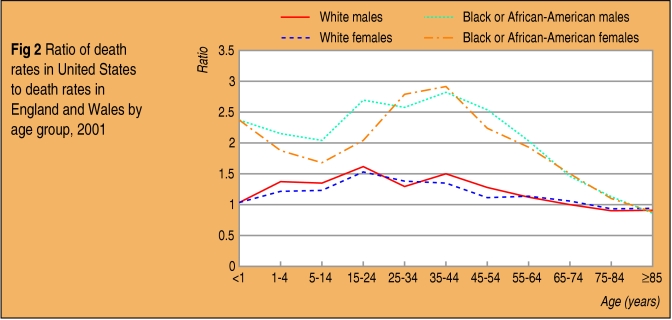The variation of health outcomes between ethnic groups is not easy to determine in the UK because ethnicity is not recorded on death certificates and is poorly recorded in hospital records. To better tackle health inequalities, more health data need to be categorised by ethnic group. Data on mortality by race are available for the United States. We compared mortality data for England and Wales with those for the United States and assessed their variation with race and age group.
The bottom line
In the United States, death rates vary greatly with race and are particularly high in black and African-American men and women. In men this is mainly related to HIV and deaths caused by firearms
Directly standardised death rates in England and Wales are similar to those in the United States, but the variation with age group is different. In people under 65 the differences are largely accounted for by the higher US death rates from HIV and firearms
Comparisons of deaths rates by race are not possible in the United Kingdom because ethnicity is not recorded on the death certificate
We compared death rates directly standardised for age and sex in England and Wales with US death rates for 2001, using the US year 2000 population as our standard. US data were further analysed by race, sex, and diagnosis. The death rates for US white and black and African-American males and females were compared with those of England and Wales for each age group by calculating the ratio of US death rates to England and Wales death rates (fig 1).
Figure 1.
Overall, standardised death rates for England and Wales were similar to the US rates, but there was considerable variation within the US data by race (fig 2). Death rates for white US males and females averaged 29% and 23% higher than those for England and Wales between ages 0 and 74, and were 9% and 6% lower for age groups 75 and over. The corresponding figures for US black and African-American men and women aged 0-74 were 130% and 115% respectively, and 0% for people aged 75 and over.
Figure 2.
The variation of US death rates for each race, age, and sex group with diagnosis indicates that deaths from HIV and those from injuries related to firearms (and hence for homicides) account for a considerable proportion of the higher death rates in the United States. If injuries related to firearms are excluded, the death rate for black and African-American men in the 15-24 age group falls from 181/100 000 to 90/100 000 (in England and Wales the firearms death rate is 0.6/100 000 for the same age group). The differences in death rates related to HIV have been falling as a result of treatment with protease inhibitor and other HIV drugs since the mid-1990s.w1 For black and African-American women aged 25-34, about a quarter of all deaths are due to complications of pregnancy, childbirth, and the puerperium, about four times the rate in white women.
In the United Kingdom, ethnicity is not recorded when deaths are registered, and ethnic group coding is missing in more than 30% of English hospital episode statistics data.w2 Although coding improved between 2001-2 and 2002-3, recording of ethnic group is still not of sufficient quality to permit robust analyses related to ethnicity. If we are to accurately determine health inequalities between ethnic groups in the United Kingdom, as is already done in the United States, recording of ethnic group within health data needs to be improved.
Supplementary Material
 Dr Foster's case notes was compiled by Brian Jarman and Paul Aylin of the Dr Foster Unit at Imperial College. Dr Foster is an independent research and publishing organisation created to examine measures of clinical performance.
Dr Foster's case notes was compiled by Brian Jarman and Paul Aylin of the Dr Foster Unit at Imperial College. Dr Foster is an independent research and publishing organisation created to examine measures of clinical performance.
 References and methodology are on bmj.com
References and methodology are on bmj.com
Associated Data
This section collects any data citations, data availability statements, or supplementary materials included in this article.




